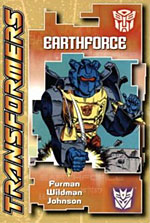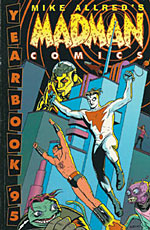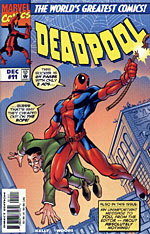>> Top Nine: Kennedy's Choice
>> Alphabetti Fumetti: V is for Vaughan
More...

Alistair Kennedy got his start writing for Ninth Art in 2001 with a reappraisal of Stan Lee's writing skills. (The conclusion was negative, though Kennedy claims he nonetheless regards 'The Man' as the greatest living American.) Since then he's written articles on what kids want from comics, comic creators who want to be rock stars, and the phenomenon of convention fancy dress. He's also the co-author of Alphabetti Fumetti and a regular contributor to the Forecast, and he currently administrates the sporadically updated pop culture blog PunchDrunk Pop. Now he gives us the rundown on the nine comics that he loves the most.
TRANSFORMERS: EARTHFORCE
Simon Furman, Andy Wildman et al
 Yeah, a few other folks who've done their Top Nine choices have named the UK TRANSFORMERS comic as being pivotal to their comics-reading habits, but that's just because it really was that good. A licensed comic about giant robot toys isn't the first thing you'd think of when coming up with a list of great literary works in the medium, and that's because it's not that at all.
Yeah, a few other folks who've done their Top Nine choices have named the UK TRANSFORMERS comic as being pivotal to their comics-reading habits, but that's just because it really was that good. A licensed comic about giant robot toys isn't the first thing you'd think of when coming up with a list of great literary works in the medium, and that's because it's not that at all.
What it is, though, is a dramatic (and often melodramatic) war story, with giant robot battles, religious overtones, an epic scope and the possibility that your favourite character could bite the dust at any time. The Earthforce stories, a series of black-and-white five-pagers, veered between multi-part action stories and one-off character pieces, and they're the Transformers equivalent of a box of Celebrations - little bite-size pieces of robot goodness. Titan has just released a series of digest-sized reprints of the whole lot. Go and buy them; they've got loads of Grimlock in them.
X-MEN #2
Chris Claremont and Jim Lee
Picture the scene, okay? I'm 11-years-old, I've been taken on a trip from my little home town up to Glasgow on the train. On the way home, I'm told I can buy a comic for the journey. Now, I'd heard of the X-Men before. A few years previously, I'd asked for a volume of the OFFICIAL HANDBOOK OF THE MARVEL UNIVERSE collected edition, simply because it had Nightcrawler on the front and he looked cool.
The comic I picked up was X-MEN #2, the penultimate teaming of Claremont and Lee, and it knocked me sideways. The first page is a splash of Magneto's growling face. Pages two and three are a double-page splash of the X-Men. Having grown up on British comics, where splash pages were practically unheard of, this was like comics in IMAX.
But I didn't know who half of these people were. Who was the guy with the long jacket and the pole? Who was the girl with the purple hair? Who was the girl who looked like a skunk? Where was Nightcrawler? And that, I think, was when I got hooked. That point right there, when I realised that there was this huge world to discover, and I'd only touched the very tip of the iceberg.
Fifteen years on, I can pick Cecila Reyes out of a line-up, but I often wish I could go back and discover it all again, just for the sheer joy of exploration.
SOLO AVENGERS #17
Tom DeFalco, Al Milgrom, Danny Fingeroth and Dave Cockrum
Now we're onto the first comic I ever bought with my own money. Back when Forbidden Planet in Glasgow was not the pine-bedecked brightly lit emporium it is now, it had black wooden back issue bins in the middle of the store - and having been given a whole shiny pound coin with which to buy myself a comic, I spent the best part of an hour poring over the history of comics (or as much history as an 11-year-old can really take in), before eventually settling on this issue. Hawkeye and the Sandman team up to take on Doctor Octopus, and in a back-up story Namor fights Goldbug.
I gave my original of this comic away to a friend a few years ago, but realised that there was a bit of a sentimental gap there and had to seek out another copy later. As far as the comic itself goes, it's nothing particularly special to write home about, but the lead story is a great deal of fun, and when you're eleven that's really all that's necessary. Sometimes it seems like that should still be the case at age 26, too.
MADMAN YEARBOOK '95
Mike Allred and Laura Allred
 Fast forward by about four years, to my first exposure to indie comics. SFX magazine's comics reviewer of the day was the estimable Matt Bielby, and his recommendations were to be trusted. I was a little wary of non-Marvel or DC comics, though. They were dangerously unpredictable - who knew what kind of R-rated stuff could be lurking within their pages?
Fast forward by about four years, to my first exposure to indie comics. SFX magazine's comics reviewer of the day was the estimable Matt Bielby, and his recommendations were to be trusted. I was a little wary of non-Marvel or DC comics, though. They were dangerously unpredictable - who knew what kind of R-rated stuff could be lurking within their pages?
One particular issue of SFX contained a rave review of a title called MADMAN. It sounded like the best thing ever - 1950s monsters, mad scientists, mutant street beatniks, and a hero with a snappy costume and a flip attitude. So I took the plunge and sought it out, making this one of the first TPBs I ever bought (as my dog-eared copy will attest). I never regretted it. In fact, I devoured the whole thing in one sitting, as I have done with pretty much every Allred comic I've managed to track down since.
MADMAN was the book that showed me that good comics don't need to have mutants or supermen in them to be good reading, and I'd drop practically every other book I buy in exchange for more adventures starring Frank Einstein and the denizens of Snap City. It's a crying shame that that's not possible right now, but who knows - maybe Mike Allred will get the itch to take the character on again. We can only hope.
NEW WARRIORS
Fabian Nicieza, Mark Bagley and Darick Robertson
Joe Quesada may believe the New Warriors to be a group of wet-behind-the-ears rookies who aren't in the same league as villains like Speedfreek and the Cobalt Man, but those of us who've been avid followers of this particular group of crime-fighting kids know that's not the case. (They took down Terrax! Firelord! The Sphinx!)
To be quite honest, I don't know exactly what it is about NEW WARRIORS that clicked so much with me as to drive me on a mission to get hold of every issue I can lay my hands on, the first book to ever have that effect on me. On the surface, it's just a group of bickering friends who angst about their lives and loves while fighting enemies without and within. That, I think, is the charm, though. Nothing ever runs smoothly for the Warriors - after #25, the culmination of the superlative 'Nothing But The Truth', the whole team were practically never together, reuniting as a whole only a couple of times more in the whole run. They fell out and fell in love with each other, built their confidence and skills, and were generally just that little bit more vulnerable than other super-teams. The closest thing in tone to NEW WARRIORS right now is YOUNG AVENGERS, and even they're all a bit too pally.
Maybe some day we'll get another WARRIORS ongoing, or even a nice juicy Essential volume, but until then I'll keep scouring back issue bins.
DAMAGE CONTROL
Dwayne McDuffie, Ernie Colón, Kyle Baker
You have to be careful with the term 'sitcomic'. There aren't many funny funnybooks that actually deserve the label. DESPERATE TIMES is one, although it would be nice if it came out more frequently. DAMAGE CONTROL, odd as it may seem, was another.
JUSTICE LEAGUE UNLIMITED honcho Dwayne McDuffie wrote all fourteen instalments of this series (in the form of two 'trailer' shorts and three four-issue minis), following John Porter, Robin Chapel and the other Damage Control employees as they clear up the messes left behind by all those super-battles that seem to cause so much property damage in New York.
What happens when Doctor Doom refuses to pay his construction bills, or when a hapless labourer finds an alien relic on a building site and is transformed into a super-hero? These are the kinds of problems the Damage Control crew faced on a regular basis, and it's to McDuffie's credit that the humour was never forced, but instead was grounded in an utterly sensible view of the Marvel Universe - why shouldn't the Fantastic Four have problems claiming on their insurance? It happens to everyone else, after all. It's absurdist realism, and hugely funny with it.
There's not much of DAMAGE CONTROL, but if you can get hold of it you most certainly should - though tracking down their first appearance in MARVEL AGE ANNUAL #4 might be a little bit of a stretch. That said, it's one of the best ideas Marvel ever published, and a little gem that the House of Ideas would be proud to publish today.
BONE
Jeff Smith
Adventure. Romance. Terror. Touching moments. Belly-laugh comedy. BONE checks all the boxes without the slightest effort. In a comics market that rewards low expectations, it's so heartening to come across a comic that actually sets its sights high and never falters from its course.
Jeff Smith's story is about three cousins of uncertain species who, having been run out of their home in Boneville, find themselves in a strange valley that's under siege from hairy monsters known as Rat Creatures. Joining forces with young Thorn Harvestar and her grandmother Rose Ben, the cousins join the struggle to rid the valley of the Rat Creatures once and for all. But a dark secret in Thorn's family, a conspiracy of dragons and the approaching threat of the evil Lord of the Locusts may mean that the Bone cousins won't be getting back home any time soon...
With BONE Smith has created something wonderful and unique - a story that can truly be appreciated and enjoyed by adults as much as by children. All volumes of BONE are available in paperback, along with the prequel ROSE, and should be sought out by anyone with a sense of romance, a willingness to be scared, and a neglected inner child in need of adventure.
The rest of you? Well, you can go back to your nap. We'll be over here, making a last stand against impossible odds. Only this time, the dragons are on our side.
DEADPOOL #1-33
Joe Kelly, Ed McGuinness and Pete Woods
 Deadpool should be a write-off. He's surely the creative nadir of the 1990s. So much a rip-off of Deathstroke that even his secret identity is 90% the same, and he's Liefeld distilled. That's the theory, anyway. Thanks to Fabian Nicieza, though, he became a mixture of Spider-Man and Bugs Bunny, but, y'know, evil.
Deadpool should be a write-off. He's surely the creative nadir of the 1990s. So much a rip-off of Deathstroke that even his secret identity is 90% the same, and he's Liefeld distilled. That's the theory, anyway. Thanks to Fabian Nicieza, though, he became a mixture of Spider-Man and Bugs Bunny, but, y'know, evil.
When Joe Kelly took on the DEADPOOL ongoing, nobody could have really had terribly high hopes. Deadpool was a one-joke character, tolerable for a guest appearance or a mini-series here and there, but not anything beyond that. So Kelly was fairly much left to his own devices, and without the X-office breathing down his neck he managed to concoct one of the best Marvel books of the 1990s.
DEADPOOL under Kelly wasn't just crazy and evil, he was a crazy, evil guy who was just sane enough to realise that maybe being evil wasn't something he should be aspiring to, and this self-loathing kept seeping out from under the wise-ass commentary he fired out like a General Electric Minigun. Used and thrown to one side by trans-dimensional manipulators Landau, Luckman and Lake, Deadpool went from cautious hope to raging self-destruction and back again, and still found time for a couple of heartfelt character moments with his dysfunctional supporting cast.
The whole run is heartily recommended, but if you can only find two issues, get hold of #11, in which Deadpool gets Forrest Gumped into a Romita issue of AMAZING SPIDER-MAN, and DAREDEVIL/DEADPOOL, where the two red-pyjama boys realise that their shared enemy/ex-girlfriend Typhoid Mary is the victim of both of their callousness. Really, though, why there isn't a line of trade paperbacks of this whole run is utterly beyond me.
GOOD-BYE, CHUNKY RICE
Craig Thompson
In 2000, I moved from Scotland to France, where I was to spend the next year. I got a copy of GOOD-BYE, CHUNKY RICE, and read it while I was there. I ended the book in a little puddle of un-manly tears.
If you've ever been away from someone you loved, then you'll see yourself on every page of GOOD-BYE, CHUNKY RICE. It's the story of Chunky Rice, a turtle who leaves his home to see what's out there, leaving behind his friend, a mouse named Dandel. He soon finds out that the wide world is a scary place, full of angry, sad people, and a loneliness that threatens to overcome him.
Thompson's work on this is less indulgent than his subsequent work BLANKETS, and every panel of every page is a quiet elegy for friendship. Dandel encourages Chunky Rice to leave, because it's what he needs to do, but then spends more and more time writing him letters in bottles that she knows will never reach him - and the other supporting characters have similar longings for companionship that none of them are quite able to articulate. It's sad without schmaltz, and poignant without pretension. It's something very special.

This article is Ideological Freeware. The author grants permission for its reproduction and redistribution by private individuals on condition that the author and source of the article are clearly shown, no charge is made, and the whole article is reproduced intact, including this notice.


